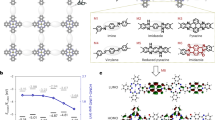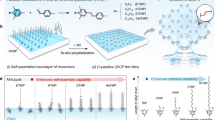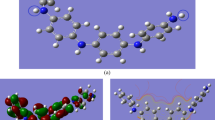Abstract
Linear conducting polymers show ballistic transport, imposed by mobile carriers moving along the polymer chains1,2, whereas conductance in the extended dimension, that is, between polymer strands or layers, remains weak due to the lack of intermolecular ordering and electronic coupling3,4,5. Here we report a multilayer-stacked two-dimensional polyaniline (2DPANI) crystal, which shows metallic out-of-plane charge transport with high electrical conductivity. The material comprises columnar π arrays with an interlayer distance of 3.59 Å and periodic rhombohedral lattices formed by interwoven polyaniline chains. Electron spin resonance spectroscopy reveals significant electron delocalization in the 2DPANI lattices. First-principles calculations indicate the in-plane 2D conjugation and strong interlayer electronic coupling in 2DPANI facilitated by the Cl-bridged layer stacking. To assess the local optical conductivity, we used terahertz and infrared nanospectroscopy to unravel a Drude-type conductivity with an infrared plasma frequency and an extrapolated local d.c. conductivity of around 200 S cm−1. Conductive scanning probe microscopy showed an unusually high out-of-plane conductivity of roughly 15 S cm−1. Transport measurements through vertical and lateral micro-devices revealed comparable high out-of-plane (roughly 7 S cm−1) and in-plane conductivity (roughly 16 S cm−1). The vertical micro-devices further showed increasing conductivity with decreasing temperature, demonstrating unique out-of-plane metallic transport behaviour. By using this multilayer-stacked 2D conducting polymer design, we predict the achievement of strong electronic coupling beyond in-plane interactions, potentially reaching three-dimensional metallic conductivity6,7.
This is a preview of subscription content, access via your institution
Access options
Access Nature and 54 other Nature Portfolio journals
Get Nature+, our best-value online-access subscription
$32.99 / 30 days
cancel any time
Subscribe to this journal
Receive 51 print issues and online access
$199.00 per year
only $3.90 per issue
Buy this article
- Purchase on SpringerLink
- Instant access to full article PDF
Prices may be subject to local taxes which are calculated during checkout




Similar content being viewed by others
Data availability
The data supporting the findings of the study are available in the paper and its Supplementary Information.
References
Chiang, C. K. et al. Electrical-conductivity in doped polyacetylene. Phys. Rev. Lett. 39, 1098–1101 (1977).
Phillips, P. & Wu, H. L. Localization and its absence—a new metallic state for conducting polymers. Science 252, 1805–1812 (1991).
Kohlman, R. S. et al. Limits for metallic conductivity in conducting polymers. Phys. Rev. Lett. 78, 3915–3918 (1997).
Kang, K. et al. 2D coherent charge transport in highly ordered conducting polymers doped by solid state diffusion. Nat. Mater. 15, 896–902 (2016).
Noriega, R. et al. A general relationship between disorder, aggregation and charge transport in conjugated polymers. Nat. Mater. 12, 1038–1044 (2013).
Wang, Z. H., Li, C., Scherr, E. M., Macdiarmid, A. G. & Epstein, A. J. Three dimensionality of metallic states in conducting polymers: polyaniline. Phys. Rev. Lett. 66, 1745–1748 (1991).
Jeon, D., Kim, J., Gallagher, M. C. & Willis, R. F. Scanning tunneling spectroscopic evidence for granular metallic conductivity in conducting polymeric polyaniline. Science 256, 1662–1664 (1992).
Xie, J. et al. Intrinsic glassy-metallic transport in an amorphous coordination polymer. Nature 611, 479–484 (2022).
Bubnova, O. et al. Semi-metallic polymers. Nat. Mater. 13, 190–194 (2014).
Lee, K. et al. Metallic transport in polyaniline. Nature 441, 65–68 (2006).
Tang, H. et al. A solution-processed n-type conducting polymer with ultrahigh conductivity. Nature 611, 271–277 (2022).
Podzorov, V. Conjugated polymers: long and winding polymeric roads. Nat. Mater. 12, 947–948 (2013).
Brondijk, J. J. et al. Two-dimensional charge transport in disordered organic semiconductors. Phys. Rev. Lett. 109, 056601 (2012).
Basescu, N. et al. High electrical-conductivity in doped polyacetylene. Nature 327, 403–405 (1987).
Sirringhaus, H. et al. Two-dimensional charge transport in self-organized, high-mobility conjugated polymers. Nature 401, 685–688 (1999).
Osterbacka, R., An, C. P., Jiang, X. M. & Vardeny, Z. V. Two-dimensional electronic excitations in self-assembled conjugated polymer nanocrystals. Science 287, 839–842 (2000).
Jin, E. Q. et al. Two-dimensional sp(2) carbon-conjugated covalent organic frameworks. Science 357, 673–676 (2017).
Liu, W. et al. A two-dimensional conjugated aromatic polymer via C-C coupling reaction. Nat. Chem. 9, 563–570 (2017).
Gutzler, R. & Perepichka, D. F. π-Electron conjugation in two dimensions. J. Am. Chem. Soc. 135, 16585–16594 (2013).
Jing, Y. & Heine, T. Making 2D topological polymers a reality. Nat. Mater. 19, 823–824 (2020).
Springer, M. A., Liu, T. J., Kuc, A. & Heine, T. Topological two-dimensional polymers. Chem. Soc. Rev. 49, 2007–2019 (2020).
Galeotti, G. et al. Synthesis of mesoscale ordered two-dimensional π-conjugated polymers with semiconducting properties. Nat. Mater. 19, 874–880 (2020).
Wang, M. et al. Exceptionally high charge mobility in phthalocyanine-based poly(benzimidazobenzophenanthroline)-ladder-type two-dimensional conjugated polymers. Nat. Mater. 22, 880–887 (2023).
Liu, K. J. et al. On-water surface synthesis of crystalline, few-layer two-dimensional polymers assisted by surfactant monolayers. Nat. Chem. 11, 994–1000 (2019).
Zhang, T. et al. Engineering crystalline quasi-two-dimensional polyaniline thin film with enhanced electrical and chemiresistive sensing performances. Nat. Commun. 10, 4225 (2019).
Tan, K. T. et al. Covalent organic frameworks. Nat. Rev. Methods Primers 3, 1 (2023).
Qi, H. Y. et al. Near-atomic-scale observation of grain boundaries in a layer-stacked two-dimensional polymer. Sci. Adv. 6, eabb5976 (2020).
Galvao, D. S., Dossantos, D. A., Laks, B., Demelo, C. P. & Caldas, M. J. Role of disorder in the conduction mechanism of polyanilines. Phys. Rev. Lett. 63, 786–789 (1989).
Krinichnyi, V. I. Dynamics of spin charge carriers in polyaniline. Appl. Phys. Rev. 1, 021305 (2014).
Huber, A. J., Keilmann, F., Wittborn, J., Aizpurua, J. & Hillenbrand, R. Terahertz near-field nanoscopy of mobile carriers in single semiconductor nanodevices. Nano Lett. 8, 3766–3770 (2008).
Huth, F. et al. Nano-FTIR absorption spectroscopy of molecular fingerprints at 20 nm spatial resolution. Nano Lett. 12, 3973–3978 (2012).
Cvitkovic, A., Ocelic, N. & Hillenbrand, R. Analytical model for quantitative prediction of material contrasts in scattering-type near-field optical microscopy. Opt. Express 15, 8550–8565 (2007).
Madsen, G. K. H., Carrete, J. & Verstraete, M. J. BoltzTraP2, a program for interpolating band structures and calculating semi-classical transport coefficients. Comput. Phys. Commun. 231, 140–145 (2018).
Liu, S. H. et al. Two-dimensional mesoscale-ordered conducting polymers. Angew. Chem. Int. Edit. 55, 12516–12521 (2016).
Kohlman, R. S. et al. Inhomogeneous insulator-metal transition in conducting polymers. Synthetic Met 84, 709–714 (1997).
Kohlman, R. S., Joo, J., Min, Y. G., MacDiarmid, A. G. & Epstein, A. J. Crossover in electrical frequency response through an insulator-metal transition. Phys. Rev. Lett. 77, 2766–2769 (1996).
Venkateshvaran, D. et al. Approaching disorder-free transport in high-mobility conjugated polymers. Nature 515, 384–388 (2014).
Wang, X. et al. High electrical conductivity and carrier mobility in oCVD PEDOT thin films by engineered crystallization and acid treatment. Sci. Adv. 4, eaat5780 (2018).
Kresse, G. & Furthmuller, J. Efficient iterative schemes for ab initio total-energy calculations using a plane-wave basis set. Phys. Rev. B. 54, 11169–11186 (1996).
Blochl, P. E. Projector augmented-wave method. Phys. Rev. B. 50, 17953–17979 (1994).
Perdew, J. P. et al. Atoms, molecules, solids, and surfaces—applications of the generalized gradient approximation for exchange and correlation. Phys. Rev. B. 46, 6671–6687 (1992).
Perdew, J. P., Burke, K. & Ernzerhof, M. Generalized gradient approximation made simple. Phys. Rev. Lett. 77, 3865–3868 (1996).
Grimme, S. Semiempirical GGA-type density functional constructed with a long-range dispersion correction. J. Comput. Chem. 27, 1787–1799 (2006).
Chang, T., Foster, D. & Kahn, A. An intensity standard for electron paramagnetic resonance using chromium-doped corundum (Al2O3: Cr3+). J. Res. Natl Bur. Stand. 83, 133–164 (1977).
Ocelic, N., Huber, A. & Hillenbrand, R. Pseudoheterodyne detection for background-free near-field spectroscopy. Appl. Phys. Lett. 89, 101124 (2006).
Maissen, C., Chen, S., Nikulina, E., Govyadinov, A. & Hillenbrand, R. Probes for ultrasensitive THz nanoscopy. ACS Photonics 6, 1279–1288 (2019).
Schnell, M., Carney, P. S. & Hillenbrand, R. Synthetic optical holography for rapid nanoimaging. Nat. Commun. 5, 3499 (2014).
Yuan, Q. et al. Thin film structure of tetraceno[2,3-b]thiophene characterized by grazing incidence X-ray scattering and near-edge X-ray absorption fine structure analysis. J. Am. Chem. Soc. 130, 3502–3508 (2008).
Talnack, F. et al. Thermal behavior and polymorphism of 2,9-didecyldinaphtho[2,3-b:2′,3′-f]thieno[3,2-b]thiophene thin films. Mol. Syst. Des. Eng. 7, 507–519 (2022).
Aradi, B., Hourahine, B. & Frauenheim, T. DFTB+, a sparse matrix-based implementation of the DFTB method. J. Phys. Chem. A. 111, 5678–5684 (2007).
Gaus, M., Goez, A. & Elstner, M. Parametrization and benchmark of DFTB3 for organic molecules. J. Chem. Theory Comput. 9, 338–354 (2013).
Lu, X. Y., Gaus, M., Elstner, M. & Cui, Q. Parametrization of DFTB3/3OB for magnesium and zinc for chemical and biological applications. J. Phys. Chem. B. 119, 1062–1082 (2015).
Acknowledgements
R.D., R.H. and X.F. acknowledge the funding support from EU Graphene Flagship (GrapheneCore3, grant no. 881603), ERC starting grant (FC2DMOF, grant no. 852909), ERC Consolidator grant (no. T2DCP). R.D., X.F., T.B. and T.H. thank Deutsche Forschungsgemeinschaft within CRC 1415 (Chemistry of Synthetic Two-Dimensional Materials, grant no. 417590517), as well as the Center of Advancing Electronics Dresden (cfaed). T.Z. acknowledges the funds from the National Natural Science Foundation of China (grant no. 52322316) and the Excellent Youth Foundation of Zhejiang Province of China (grant no. RG25E030003). R.D. acknowledges the National Natural Science Foundation of China (grant nos. 22272092 and 22472085). S.C. acknowledges the funds from the National Natural Science Foundation of China (grant nos. 61988102, 6242200987 and 62301319) and the Science and Technology Commission of Shanghai Municipality (grant nos. 23010503400 and 23ZR1443500). We acknowledge P. Mack and L. Kaeselitz from Thermo Fisher Scientific (UK) for the assistance of μXPS characterization. R.H. acknowledges financial support from Grant CEX2020-001038-M funded by the Spanish MICIU/AEI/10.13039/501100011033 and Grants RTI2018-094830-B-I00 and PID2021-123949OB-I00 funded by the Spanish MICIU/AEI/10.13039/501100011033 and by ERDF/EU. P.L acknowledges the National Natural Science Foundation of China (grant no. 62075070), the Hubei Optical Fundamental Research Center, and the Innovation Fund of WNLO. T.B., T.H. and P.P.P. thank ZIH Dresden for providing computational resources. We acknowledge ELETTRA Sincrotrone Trieste for providing access to its synchrotron radiation facilities and we thank L. Barba for assistance in using beamline XRD1. The research leading to this result has been supported by the project CALIPSOplus under grant agreement no. 730872 from the EU Framework Programme for Research and Innovation HORIZON 2020.
Author information
Authors and Affiliations
Contributions
T.Z., R.D., R.H. and X.F. conceived the idea and supervised the project. T.Z. and P.Z. performed the synthesis and basic characterization and data analysis. S.X. supported the experiment of model reaction. S.C., P.L., L.M. and R.H. carried out the terahertz and IR nanospectroscopy measurements and analysis. P.P.P., T.B. and T.H. implemented the DFT calculations. H.Q., U.K., Z.L. and E.Z. performed SAED and HRTEM characterization and analysis. N.N.N. carried out c-AFM and analysis. N.N.N., J.Y., W.Z. and S.S.P.P. carried out the study of micro-devices. A.A., V.K., and B.B. performed ESR study. M.H. and S.C.B.M. supported GIWAXS study. All authors discussed the results and assisted with manuscript composition.
Corresponding authors
Ethics declarations
Competing interests
R.H. is a cofounder of Neaspec GmbH, which is now a part of attocube systems AG, a company producing scattering-type scanning near-field optical microscope systems, such as the ones used in this study. The remaining authors declare no competing interests.
Peer review
Peer review information
Nature thanks Reverant Crispin, Wenping Hu and the other, anonymous, reviewer(s) for their contribution to the peer review of this work.
Additional information
Publisher’s note Springer Nature remains neutral with regard to jurisdictional claims in published maps and institutional affiliations.
Supplementary information
Supplementary Information
Supplementary Figs 1–36 and Tables 1–6.
Rights and permissions
Springer Nature or its licensor (e.g. a society or other partner) holds exclusive rights to this article under a publishing agreement with the author(s) or other rightsholder(s); author self-archiving of the accepted manuscript version of this article is solely governed by the terms of such publishing agreement and applicable law.
About this article
Cite this article
Zhang, T., Chen, S., Petkov, P.S. et al. Two-dimensional polyaniline crystal with metallic out-of-plane conductivity. Nature 638, 411–417 (2025). https://doi.org/10.1038/s41586-024-08387-9
Received:
Accepted:
Published:
Issue date:
DOI: https://doi.org/10.1038/s41586-024-08387-9
This article is cited by
-
Fundamentals of charge transport in two-dimensional framework materials
Nature Reviews Materials (2025)
-
Evolving Role of Conjugated Polymers in Nanoelectronics and Photonics
Nano-Micro Letters (2025)
-
Two-dimensional polyaniline becomes a metal
Science China Chemistry (2025)



